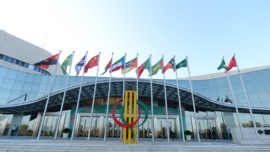The United States Federal Reserve is the worlds most powerful bank, and its most powerful component is the Federal Open Market Committee (FOMC), the twelve men and women who meet eight times a year to determine essentially by setting interest rates the monetary policy of the worlds largest economy. The last time the Fed raised interest rates was in 2006, before the growth-sapping impact of the global financial crisis persuaded it and other central banks to lower rates effectively to zero and to employ so-called quantitative easing (QE) to pump money into advanced economies. But this year, for the first time since 2007, every advanced economy in the world is growing including Americas. And that means that the FOMC, fearful of asset bubbles, will at some point decide that Americas interest rates must rise. That may (or may not, depending on the timing) be good for the US economy, but what will it mean for the rest of the world? Our research shows why the world, especially emerging countries, will be paying nervous attention. In mid-2013, when the Fed announced that it would gradually reduce its unconventional monetary-policy measures (for example, large-scale purchases of mortgage-backed securities), emerging markets suffered large capital outflows. In other words, when the Fed even hints at tightening monetary policy, other countries suffer. Depending on just how much the FOMC decides to tighten at a future meeting, we foresee negative effects on world GDP in the medium term, not only for emerging markets but also for industrialized economies. Since the Fed started to curb its QE program, there has been constant speculation over just when its current accommodative monetary policy will end. Market participants, be they lenders or borrowers, know that easy money has an expiry date. They can see that after three large asset-purchase programs, the Feds balance sheet has more than quadrupled since 2007, totalling about US$4.5 trillion in February 2015. However, when assessing what the FOMC intends to do, it is important to bear in mind that the Feds mandate is to advance Americas national economic goals. This means that it has to consider not just the desirable rate of inflation (the target is a 2% annual rate), but also the state of the labour market and its judgment has global implications. That is why the Feds talk in mid-2013 about a gradual exit from unconventional monetary policy led to a so-called taper tantrum among investors, triggering a surge in global volatility and a shift in market sentiment against emerging markets. The question now is whether future changes by the FOMC in the federal funds rate (the interest rate at which banks lend each other their overnight money deposited at the Fed) will have similar, or indeed worse, effects. To narrow any gap between its expectations for the economy and those of the public, the Fed publishes each FOMC members view of the range of interest rates that should be expected over the next few years. A member with a positive assessment of the US economys growth prospects will expect a rise in the federal funds rate; a pessimist will expect the rate to stay close to zero for a longer period. Using information released by the Fed in March, we have constructed two scenarios: lift-off is based on the maximum projected interest rates, while delayed lift-off is based on the minimum. To see the impact beyond America on GDP, consumer prices, exchange rates, and interest rates, we then apply the scenarios to a total of 36 emerging and advanced economies that together account for 90% of global output. Assuming a phased rise in the federal funds rate to 4% by 2017, we believe that economic growth in all regions except Latin America will slow in 2016, and then slow even more in 2017. The cumulative loss in this lift-off scenario is about ten times as large as any lost economic output under the delayed lift-off alternative of only minimal changes to rates over the next couple of years. Our research shows that any monetary tightening by the Fed will affect the rest of the world, but to differing degrees. Those emerging markets that were hit severely during the taper tantrum episode for example, Brazil, Indonesia, and Turkey will certainly suffer. But the greatest negative impact will be on countries such as Canada and Mexico, which have close trade links with the US economy or those, like Germany, Japan, and Singapore, that are deeply integrated into the global economy. In other words, though emerging markets through their dependence on capital inflows will be at risk when Americas monetary policy eventually returns to normal, the same will be true for advanced economies.
Top Stories
RELATED ARTICLESMORE FROM AUTHOR
Enhancing Macau’s Role as a Bridge between China and Portuguese-speaking Countries for Building a Community...
By Liu Xianfa, Commissioner of the Ministry of Foreign Affairs of the People’s Republic of...
OPINION – Enhancing Tourist Experience and Protection: Recommendations for the Historic Centre of Macau
Macau, as a travel destination, is world-renowned for its vibrant entertainment gambling, rich cultural heritage,...
OPINION – The Influence of Many, the Power of One
In January of this year, I reached out to my Corporate Social Responsibility expert colleagues...
OPINION – Blue natural assets
The sea seems cheap. Water does not have to be built (like railways) or repaired...























